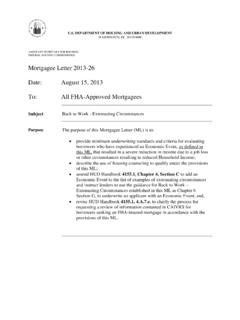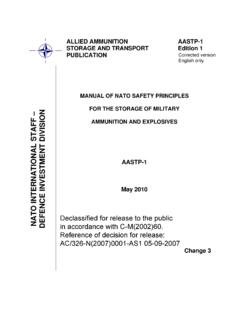Transcription of Consultation letter - evacuation and escape from …
1 Consultation WITH THE RAILWAY INDUSTRY: COMPLIANCE WITHRECOMMENDATION 63 OF CULLEN PART 1 REPORT - DRAFT HSE GUIDANCE ONTHE PROVISION OF EQUIPMENT AND ARRANGEMENTS FOR THE EVACUATIONAND escape OF PERSONS FROM TRAINS IN AN EMERGENCYYou are invited to comment on the attached guidance by 22nd April 2002. As part of theconsultation exercise the railway industry is required to: i) review the draft HSE guidance on evacuation and escapeii) identify measures/initiatives which could be used to demonstrate how compliance with theHSE guidance will be achieved and suggest how this might be : Appendix B of the attached document will not form part of the published guidance andhas only been attached for information only. It includes:i) The HSE interpretation of recommendation 63 of the Cullen Part 1 report on the inquiry intothe Ladbroke Grove Collision and the requirements to be ) The HSE action plan to comply with recommendation comments should be forwarded to:Eur Ing Toyin DaviesHM Inspector of Railways2nd Floor, 2 Southwark BridgeLondon SE1 9 HSTel: 0207 717 6620 Email: HM RAILWAY INSPECTORATE HSE GUIDANCE ON THE PROVISION OF EQUIPMENT AND ARRANGEMENTS FOR THE evacuation AND escape OF PERSONS FROM TRAINS IN AN EMERGENCY HSE COMPLIANCE WITH RECOMMENDATION 63 OF CULLEN PART 1 INQUIRY REPORT INTO THE LADBROKE GROVE COLLISION Consultation WITH THE RAILWAY INDUSTRY MARCH 2002 1 FOREWORD This booklet contains extracts and re-presented information from HSE guidance which deal with evacuation and escape from trains.
2 The style and level of detail contained within its various parts may therefore vary. The booklet is divided into four parts. Each part draws from the relevant sections of HSE guidance on emergency evacuation and escape from trains, as follows: Part 1 Paragraphs 250-252 of the guidance to the Railways (Safety Case) Regulations 2000 including 2001 amendments, HSE ref. L52. Part 2 Criteria and and related paragraphs 66-71 and 30-38 of the Safety Case Assessment Criteria prepared by HSE to establish the criteria for its assessment of Railway Safety Cases under the Railways (Safety Case) Regulations 2000. Part 3 Various paragraphs contained within Railway Safety Principles and Guidance Part 2 section F Trains 1996, HSE ref. HS (G) 153/7, as amended in February 2002. The requirements contained within these paragraphs have been re-presented in a new narrative. This re-presentation has been necessary because there is no single section within Railway Safety Principles and Guidance Part 2 section F Trains (RSPG Part 2F) which is specifically concerned with evacuation and escape from trains and which could have been extracted.
3 RSPG Part 2 section F is one of a series of booklets published in 1996 providing high-level guidance and advice to those involved in the design and construction of new and altered works, plant and equipment which require approval under the Railways and Other Transport Systems (Approval of Works, Plant and Equipment) Regulations 1994. The guidance contained in RSPG Part 2 section F is principally concerned with the design features of trains and the equipment to be carried on trains including those which may facilitate evacuation and escape . Part 4 Guidance on train/vehicle evacuation or escape to be contained in a document to be entitled Safe Movement of Trains. The Railway Safety Principles and Guidance series is being extended to cover management and operational issues and Safe Movement of Trains is currently under development as part of the extended series. It will set principles and provide guidance on the operation of trains rather than their design and construction or the equipment carried on them.
4 It will include high-level guidance on the operational aspects of train evacuation and escape and this is extracted here. The whole document is expected to be published, following wide Consultation , in late 2002 or early 2003. 2 References A list of the relevant regulations, approved documents and other publications mentioned in this guidance is contained in Appendix A. 3 CONTENTS Page No. Introduction 4 Part 1: Paragraphs 250-252 of the guidance to the Railways (Safety Case) Regulations 2000 including 2001 amendments 5 Part 2: Criteria and and related paragraphs 66-71 and 30-38 of the HSE Safety Case Assessment Criteria 6 Part 3: Various paragraphs contained within Railways Safety Principles and Guidance Part 2 section F Trains 1996 8 Part 4: Guidance on train/vehicle evacuation or escape to be contained in a document to be entitled Safe Movement of Trains 10 Appendix A References 12 Appendix B Cullen Part 1 Recommendation 63: Interpretation and Requirements 13 Railway Inspectorate s Action Plan 4 Introduction Background The subject of evacuation and escape from trains has achieved high profile following the collision at Ladbroke Grove in 1999.
5 This publication brings together existing guidance produced by the Health & Safety Executive on the subject and new guidance contained in a document currently under development. evacuation in an emergency is regarded as the controlled egress of passengers from a train or vehicle to a place of safety which is supervised by railway or emergency services personnel, whereas escape in an emergency is regarded as the unsupervised egress of passengers from a train or vehicle to a place of safety. In the latter circumstances passengers may follow the advice of train signage and instructions provided, and may use on board emergency equipment, emergency door release devices, or any emergency exit windows. This guidance is primarily intended for use by train operating companies in the development of their Railway Safety Cases. It will also be of use to rolling stock manufacturers and leasing companies and others. All employers will need to have systems in place to ensure that their staff are competent to undertake the various tasks required of them.
6 Recommendation 63 Recommendation 63 of Part One of Lord Cullen s Inquiry into the accident at Ladbroke Grove requires adequate guidance to be produced by the Health and Safety Executive to support the provisions in Schedule 1 to the Railways (Safety Case) Regulations 2000 as to evacuation and escape from trains. The guidance contained in this booklet will enable the recommendation to be achieved. The relevant provisions in Schedule 1 to the Railways (Safety Case) Regulations 2000, as amended by the Railway Safety (Miscellaneous Amendments) Regulations 2001, are as follows: 15 Particulars of the arrangements the duty holder has established- (c) for the provision of equipment and arrangements for the evacuation of persons in an emergency from trains operated by the duty holder; and (d) for the provision of equipment and arrangements for the escape of persons in an emergency from trains operated by the duty holder. 5 Part 1 Paragraphs 250-252 of the guidance to the Railways (Safety Case) Regulations 2000 including the 2001 amendments, HSE ref.
7 L52 (rev). 250 The safety case should describe the equipment and arrangements in place for facilitating the evacuation and escape from trains in an emergency. This covers emergency exits; facilities for the removal of windows where applicable, such as hammers; door emergency release devices, escape lighting; signs indicating emergency exits or equipment; training of on-board staff in evacuation procedures; and information and instructions to passengers. The equipment and arrangements to be provided on different types of train will depend on the type of train, and on practicalities. Equipment needs to be: (a) sufficient, so that it is available to all staff and passengers when needed; (b) suitable, so that it performs its intended function satisfactorily in the conditions in which it will be foreseeably used; (c) suitably sited, so that it is easily accessible while not providing an obvious target for vandalism; and (d) easy to use, regarding the conditions in which it may be used, including poor light.
8 251 The duty holder should describe the arrangements to provide suitable instructions for passengers on the means of escape and on the use of the emergency equipment provided. This includes information on the position of escape routes, escape route signs and any emergency exits, and how to use the exits in emergency, including, where appropriate, the information describing the means of releasing doors in an emergency. This information could be provided in writing, in the form of an illustrated card provided at each seat, through information notices and/or announcements. Simple, bold instructions also need to be provided on the release and use of hammers and other emergency devices, placed next to hammers and capable of being read in poor light. 252 Where changes are proposed to train interior design, equipment, or evacuation and escape procedures, the effectiveness of the arrangements as a whole will need to be carefully assessed. Amendments to the safety case will need to be considered and submitted to HSE, as necessary.
9 It should be noted that in this booklet minor amendments have been made to paragraphs 250 and 251 of the existing guidance. L52 is scheduled to be revised in autumn 2002 and this will take account of all appropriate changes proposed during the Consultation of this document. 6 Part 2 Criteria and and related paragraphs 66-71 and 30-38 of the Safety Case Assessment Criteria produced by HSE, April, 2002 Criterion : The Safety Case should provide details of the equipment provided and the procedures implemented to enable the safe evacuation or escape when necessary from trains. Reasons 66. Schedule 1(15)(c) and (d) requires: "Particulars of the arrangements the duty holder has established - (c) for the provision of equipment and arrangements for the evacuation of persons in an emergency from trains operated by the duty holder" (d) for the provision of equipment and arrangements for the escape of persons in an emergency from trains operated by the duty holder.
10 In the event of an accident it is foreseeable that both passengers and employees may have to escape /evacuate from damaged parts of the train. Unless the passengers health and safety is at risk they should be encouraged to remain within the train until the emergency services arrive. Examples of evidence 67. The procedures for ensuring safe evacuation of trains. These should cover all persons on the train and all types of trains including passenger, freight and engineer's trains. 68. Preference is given to disembarking passengers at a station or transferring them to another train to continue to the disembarkment point. 69. The procedures take account of any factors, which may present additional risks including, for example, the presence of tunnels and third-rail traction current systems. 70. The arrangements for training of staff in emergency procedures including the testing of procedures in various scenarios. 71. The equipment provided to enable the safe evacuation of trains.


















